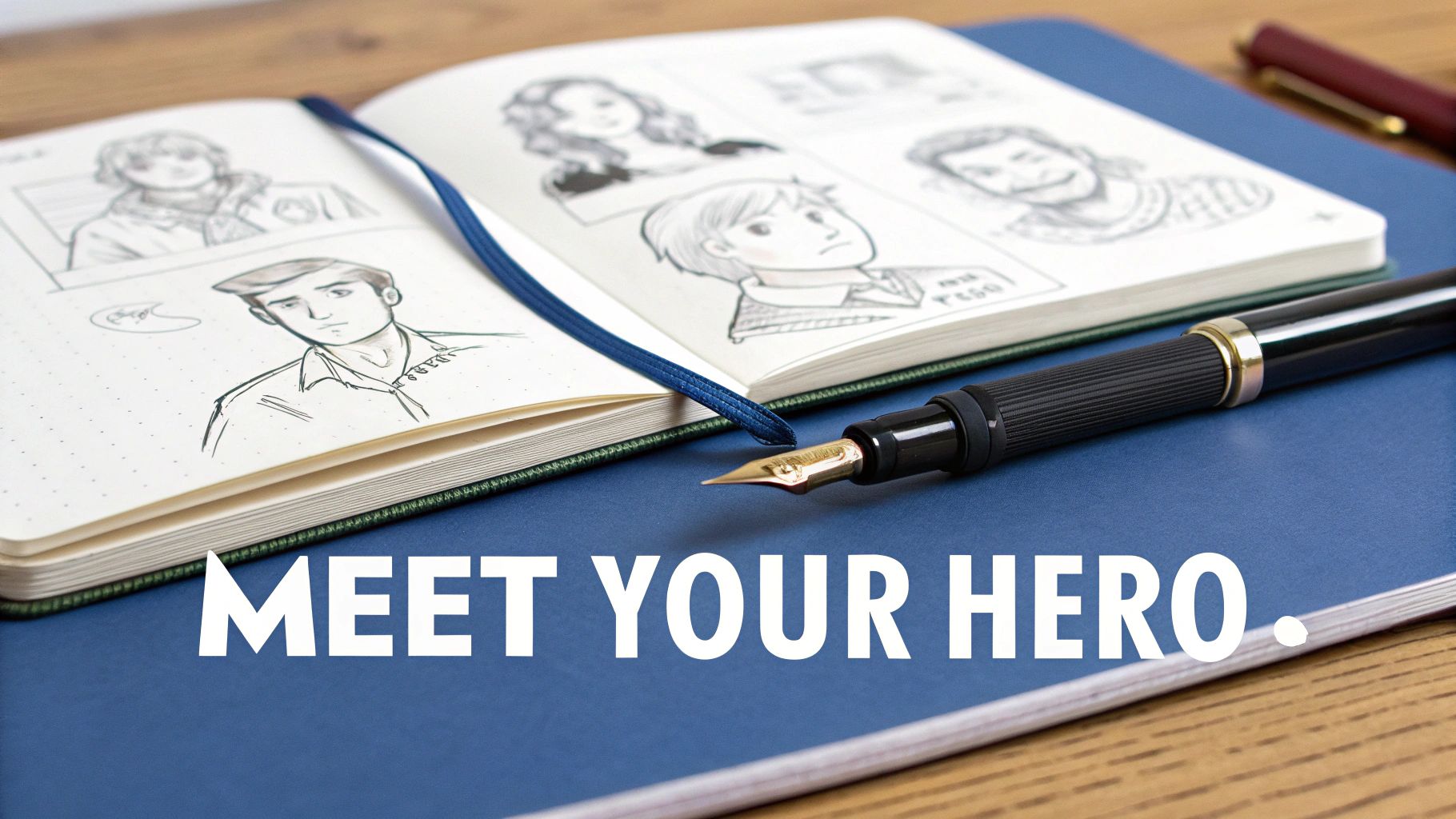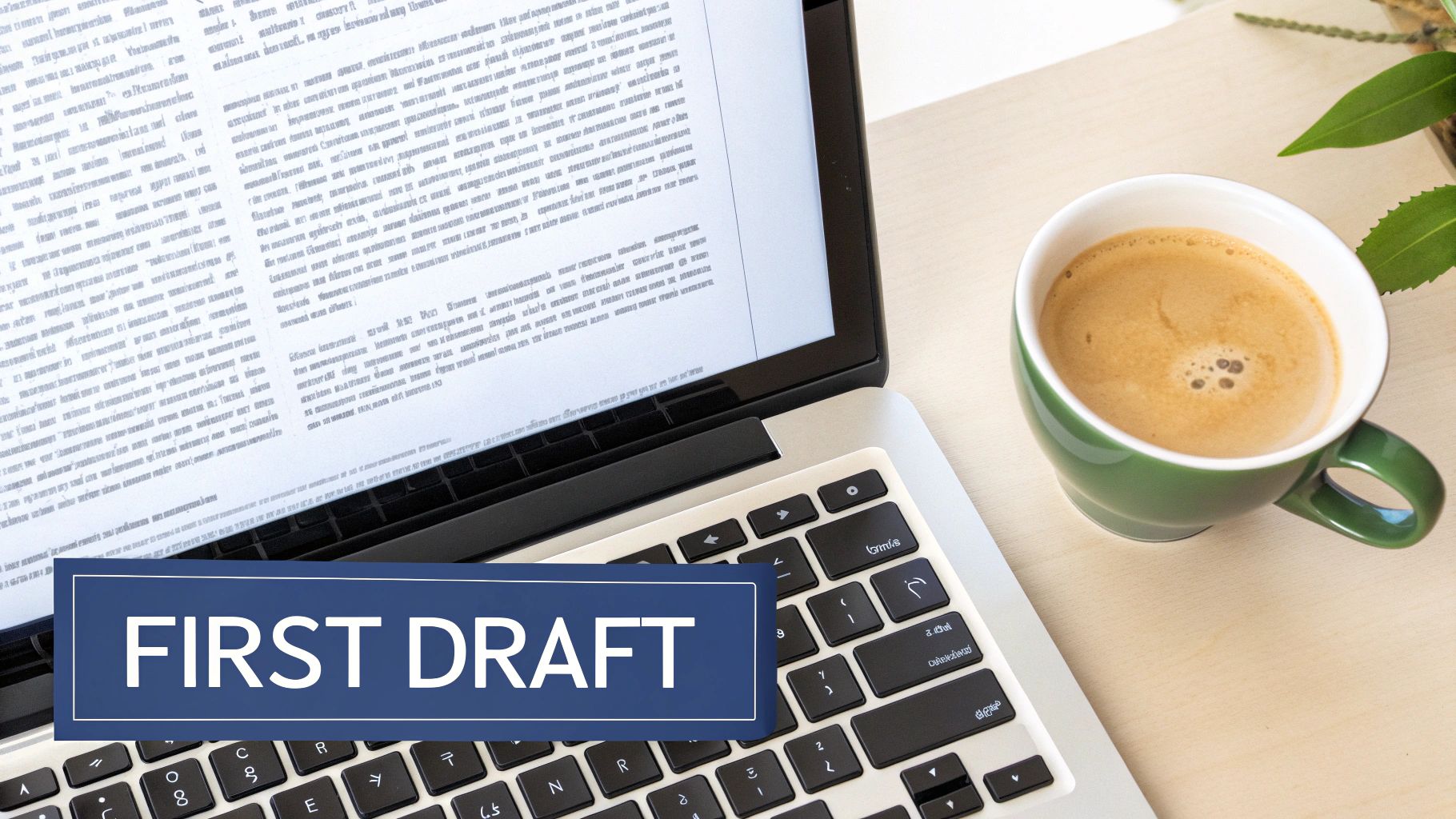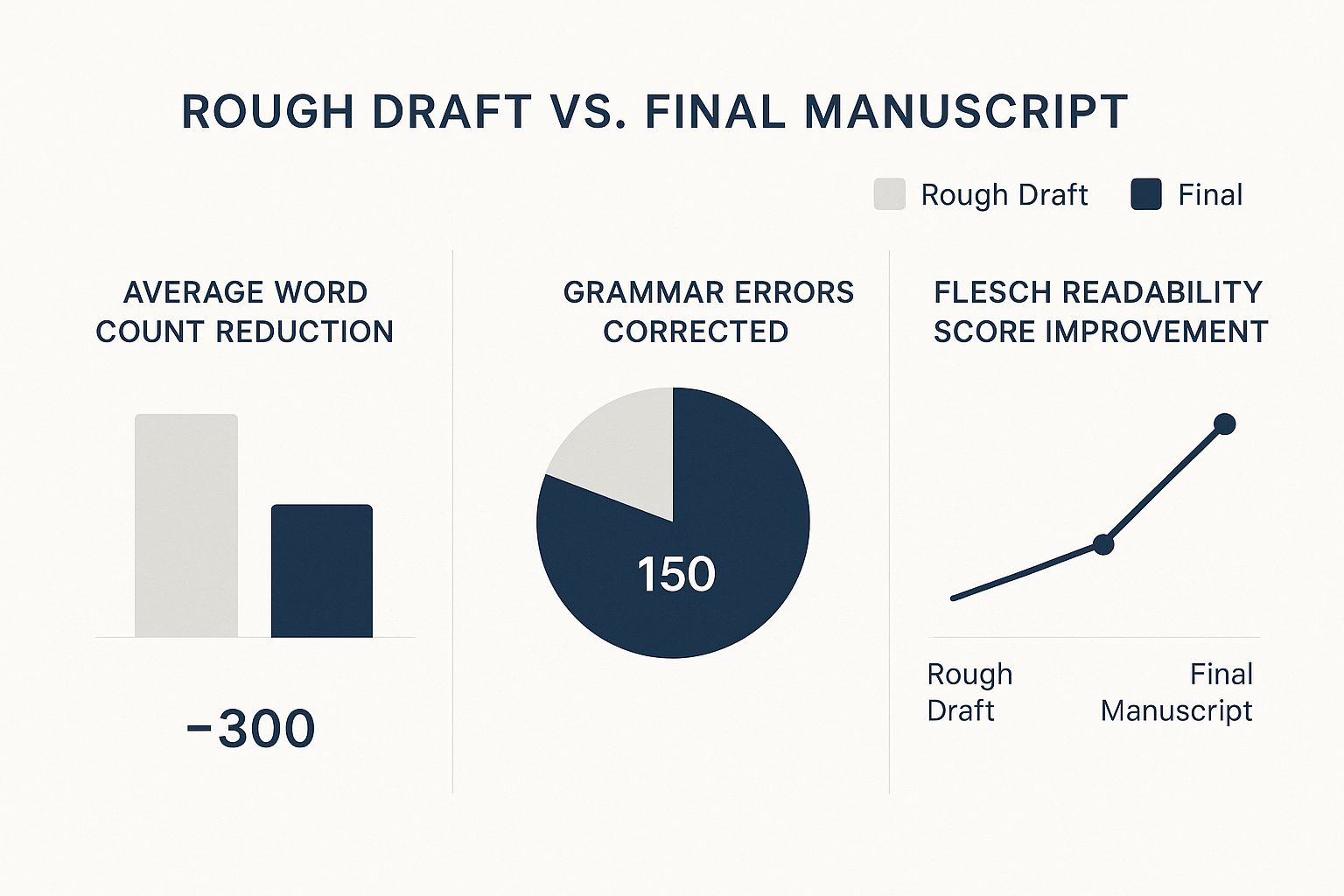Bringing a book to life is a journey, one that takes you from a simple idea all the way to a finished work in the hands of readers. It's a process that breaks down into a few key phases: brainstorming and outlining your concept, drafting the manuscript, editing it until it shines, designing a compelling package, and finally, getting it out into the world.
Laying the Groundwork for Your Book

Every great book starts long before the first sentence is written. It begins with a solid plan. This is the foundational stage where you turn a fleeting thought into a real blueprint, a step that will save you from endless, frustrating rewrites later on. It’s all about asking the right questions before you commit to the marathon of writing.
Think of it like building a house. You wouldn't just start laying bricks without architectural plans, right? You need to know the layout, the dimensions, and where everything fits. It's the exact same with a book—you have to define its structure and purpose first.
From Spark to Viable Concept
That initial idea is just the starting point. The real work begins when you pressure-test that concept to see if it can stand on its own as a full book. The most important question to answer is: who is this book for? What problem does it solve for them, or what world does it let them escape into?
Trying to write a book for "everyone" is a classic mistake that usually results in a book that connects with no one.
So, get incredibly specific about your ideal reader. Picture them in your mind:
- What are their biggest struggles or passions?
- What other books are on their nightstand?
- What social media platforms do they use?
- What kind of tone and style will they actually enjoy reading?
Really knowing your audience is what makes your idea viable. If you're writing non-fiction, this might mean running a survey or just studying the top-selling books in your niche. If you're a novelist, it's about understanding genre conventions—not to be formulaic, but to know the sandbox you're playing in.
Building Your Book's Skeleton
With a solid concept in hand, it's time to create an outline. This doesn't have to be some rigid, multi-page document (unless that's what works for you). An outline is simply your roadmap. It ensures your book has a logical flow and doesn't leave out anything important.
Historically, authors have spent months, or even years, writing and revising a manuscript to get it right. A good outline is your best shortcut to a coherent first draft.
As you build this structure, grounding your work in the principles of compelling storytelling can make all the difference in connecting with your audience. For a deep dive into the nuts and bolts of structuring your manuscript, our guide on https://barkerbooks.com/how-to-write-a-book-outline/ is packed with actionable methods and examples.
Your outline is your book’s backbone. It provides structure and direction, ensuring your narrative or argument doesn't meander. Whether it’s a simple bulleted list of chapters or a detailed scene-by-scene breakdown, it's the most critical tool for an efficient writing process.
The best outlining method really depends on your writing style and the nature of your project. Here’s a quick look at some popular options to help you decide.
Choosing the Right Book Outlining Method
| Outlining Method | Best For | Key Advantage |
|---|---|---|
| The Snowflake Method | Complex plots and character-driven fiction | Builds the story organically from a single sentence into a full structure. |
| The Mind Map | Visual thinkers and non-linear brainstorming | Allows for free-flowing connections between ideas before organizing them. |
| Chapter-by-Chapter | Non-fiction and straightforward narratives | Provides a clear, linear path that is easy to follow during the writing phase. |
| The Three-Act Structure | Screenwriters and many fiction genres | Delivers a classic narrative arc with a clear beginning, middle, and end. |
Picking a method that clicks with how your brain works will make the entire process feel more natural and less like a chore. This planning is what keeps your momentum going and prevents that dreaded "what comes next?" feeling from derailing your project.
Drafting Your Manuscript Without Losing Momentum
You’ve got your blueprint. Now comes the hard part—and the fun part. This is where you start building the house, turning a collection of notes and outlines into an actual, tangible manuscript. It’s also where most aspiring authors get bogged down by the sheer pressure of it all.
Let's get one thing straight right away: a first draft has one job and one job only—to exist. It doesn't need to be brilliant. It doesn't need to be polished. It just needs to get done. Trying to write and edit at the same time is a recipe for disaster. You’ll stall out, get frustrated, and maybe even quit. So, for now, just write.
Finding Your Sustainable Writing Rhythm
Forget the myth of the tortured artist who writes for eight hours straight every day. For most of us with jobs, families, and lives, that’s completely unrealistic. The real secret to finishing a book isn't about marathon sessions; it's about consistency.
You need to find a rhythm that actually fits into your life. What does that look like in practice?
- Time Blocking: Look at your calendar and carve out non-negotiable writing appointments. Maybe it's 7 AM to 8 AM every Tuesday and Thursday. Maybe it’s 30 minutes on your lunch break. Whatever it is, treat it like a meeting you can't miss.
- Word Count Goals: Instead of focusing on time, focus on output. A goal of 500 words, three times a week, feels way more achievable than a vague promise to "write more." It adds up faster than you think.
- Writing Sprints: Use a timer and go all-out for short bursts. The Pomodoro Technique is a classic for a reason: 25 minutes of focused writing, followed by a 5-minute break. You’ll be shocked at how many words you can get down when you know the clock is ticking.
Experiment a little. Try different methods for a week or two and see what sticks. Once you find your groove, that rhythm becomes the engine that powers you all the way to "The End."
Push Through the Inevitable Friction
Every single writer hits a wall. I don't care if you're a first-timer or a seasoned pro. The plot gets tangled, the words feel stale, and that little voice of self-doubt starts whispering in your ear. This is just writer's block, and it's a totally normal part of the process. The trick is to not let it win.
When you feel yourself grinding to a halt, switch things up. Jump ahead to a scene you’re actually excited to write. Ditch the keyboard and try writing longhand in a notebook to fire up a different part of your brain. If you’re really stuck, our guide on https://barkerbooks.com/overcoming-writers-block/ has some great, practical techniques to get the words flowing again.
A finished first draft is a win, period. It doesn’t matter if it’s messy, clunky, or full of plot holes. Perfectionism is the enemy of progress right now. Give yourself permission to write terribly.
Sometimes, the biggest hurdle is just staying disciplined. This is where finding a writing accountability partner can be a game-changer. Just knowing someone is going to ask, "Hey, did you hit your word count this week?" provides that little bit of external motivation to keep you on track.
The Power of Separating Creator and Critic
Think of your brain as having two different modes: the Creator and the Critic. When you’re drafting, your only job is to let the Creator run wild. Let the ideas flow. Let the sentences be awkward. Just get it all out there.
The moment you start agonizing over word choice or fixing a typo, you’ve let the Critic into the room. And the Critic’s job is to poke holes in everything. That’s incredibly valuable during the editing phase, but right now, it will only slow you down and fill you with doubt.
I like to think of a first draft as sculpting with a huge, messy lump of clay. You’re just trying to get the basic shape down. The fine-tuning comes much, much later.
Here’s a simple way to remember which hat you should be wearing.
| The Creator (Drafting Mindset) | The Critic (Editing Mindset) |
|---|---|
| Focuses on getting words out | Focuses on refining words |
| Embraces imperfection and messiness | Seeks clarity and precision |
| Prioritizes momentum and story flow | Prioritizes grammar and style |
| Asks "What happens next?" | Asks "Is this the best way to say this?" |
By consciously keeping these two roles separate, you give yourself the freedom to draft faster and with far more confidence. You can’t edit a blank page, after all. Your messy, imperfect, and wonderfully complete first draft is the raw material for all the magic that comes next.
The Art of Editing and Refining Your Draft

So, you’ve done it. You have a finished first draft. That messy, imperfect, and wonderfully complete document is the single biggest milestone in this whole book-creation journey. Take a moment to celebrate that. Now, the real work begins—shaping that raw clay into something polished and ready for readers.
There's a reason you hear the old saying, "writing is rewriting." That first draft was for you. It was your chance to get the story out, to explore the ideas without judgment. The editing process is where you make it for everyone else.
This isn't about a single, frantic pass with a red pen. True editing is a layered approach, starting with the 10,000-foot view and gradually zooming in on the tiniest details.
The Self-Editing Deep Dive
Before anyone else sees this manuscript, you need to be its first and harshest critic. This initial phase, often called developmental editing, has absolutely nothing to do with commas or typos. It’s all about the architecture of your book.
You're hunting for the big, structural problems that can sink the entire project. The best way to do this? Step away. Let your manuscript sit for a few weeks—a month is even better. When you come back to it, you’ll have the fresh eyes you need to ask the tough questions:
- For Fiction: Does the plot actually hold together? Are there gaping plot holes? Is the pacing off—does Chapter 5 drag on forever while the climax feels rushed? Do your characters grow and change in a believable way?
- For Non-Fiction: Is your main argument clear and consistent from start to finish? Does the structure flow logically, or do you jump around? Is there redundant information you can cut, or crucial pieces you've missed?
This is your macro-level work. You might realize a secondary character needs to be cut entirely, a chapter needs a ground-up rewrite, or the entire second half needs reordering. It can feel brutal, but fixing these foundational issues now will save you a world of hurt later.
Polishing at the Sentence Level
Once you’re confident in the book's bones, it’s time to zoom in for the line edit. Here, you’re focusing on the craft of the writing itself—the flow, the rhythm, the feel of your prose. You’re no longer moving walls; you’re picking out paint colors and arranging the furniture.
Your goal is to make every sentence clean, clear, and engaging. A great trick is to read your manuscript aloud; you'll immediately hear the clunky phrasing and awkward sentences your eyes skip over. Hunt down repetitive words and tired clichés. Swap out vague language for words with punch and precision. This is where your authorial voice really starts to sing.
"To write is human, to edit is divine." – Stephen King
After that comes copyediting, the final mechanical polish. This is where you obsess over the small stuff: grammar, spelling, punctuation, and consistency. Did you spell a character’s name one way in Chapter 2 and another way in Chapter 22? Are you following a consistent style guide? This detailed pass ensures a professional finish.
Bringing in Outside Eyes
Look, you can only take your manuscript so far on your own. After reading it for the tenth or twentieth time, you become blind to its flaws. That’s when you absolutely must bring in fresh perspectives.
Start with beta readers. These are not your mom or your best friend (unless they can be brutally honest). They should be people who represent your target audience. Give them a clean copy and ask for high-level, constructive feedback on the story and characters. Their reactions are pure gold—they’ll tell you if your jokes are landing, if your arguments are persuasive, and if that big twist actually surprises them.
After you've processed the beta feedback, it’s time to consider hiring a pro. A professional editor brings an expert, unbiased eye to your work. They catch the mistakes you've read a hundred times and offer invaluable guidance on everything from structure to word choice. While it’s an investment, a good editor is often what separates an amateur-feeling book from a truly professional one. They'll ensure your manuscript is the absolute best version of itself before it moves on to the next stage.
Designing a Book That Readers Want to Own

After pouring your heart and soul into writing and editing, it’s so tempting to just slap a cover on it and hit "publish." Don't do it. That's a huge mistake I see far too many authors make.
Your book’s design is its first handshake with a potential reader. It sets the tone and makes a powerful, split-second promise about what’s inside. An amateur design screams "amateur author," no matter how brilliant your manuscript is. To create a book that doesn't just get read but gets owned and displayed on a shelf, both your cover and interior need professional attention.
Crafting a Cover That Sells
Think of your book cover as your single most important marketing asset. In a crowded online bookstore, it has less than a second to grab someone’s attention and tell them what your book is about. A blurry image or clashing fonts? They'll just keep scrolling.
A great cover pulls off three things almost instantly:
- It nails the genre. A gritty thriller cover looks nothing like a sweet romance or a sharp business book. Readers depend on these visual cues.
- It sparks an emotional reaction. The goal is to make someone curious, excited, or intrigued enough to click for more information.
- It looks professional. This is non-negotiable. It means clean typography, a balanced composition, and high-quality imagery.
You don't have to be a graphic designer to get this right. While tools like Canva offer great templates, the surest way to a standout cover is to hire a professional designer who specializes in books. They live and breathe this stuff, and they know how to translate your vision into something that sells.
Designing an Inviting Interior
The cover gets readers in the door, but the interior design is what makes them stay. A poorly formatted book is a chore to read, and it can pull someone right out of the world you’ve built. The real goal is a seamless, almost invisible design that lets the reader get lost in your words.
The best interior design is one the reader never notices. It removes all friction between them and your story, making the act of reading effortless and enjoyable.
This all comes down to the details. Modern publishing has really changed how this works, with technology like print-on-demand (POD) making it easier to produce books once the design is locked in. For a look at what's happening across the industry, Anna Featherstone's blog is a great resource for current trends.
Key Elements of Interior Formatting
Getting the interior right means sweating the small stuff. These are the details you absolutely have to get right for both print and ebooks.
- Font Selection (Typography): For body text, stick with a classic, readable serif font like Garamond or Caslon. For headings, a clean sans-serif creates a nice contrast and helps with navigation.
- Margins and White Space: Don't cram your text to the edges of the page. Generous margins make the content feel more approachable and less intimidating.
- Chapter Headings: Make sure your chapter titles and page numbers are consistent. It’s a small touch that gives the entire book a cohesive, professional feel.
- Trim Size: The physical size of your book (a 6×9 inch trim is common for novels) directly impacts your page count, which in turn affects your printing costs.
Nailing these details is crucial for creating a book that feels high-quality. We get into the nitty-gritty of this in our guide on book design and layout essentials. Ultimately, a well-designed book shows respect for your reader, making it a pleasure to experience from the first glance to the final page.
Choosing Your Path to Publication
You've done it. The manuscript is written, revised, and as polished as you can make it. Now comes the big question: how do you get this book into the world and into the hands of readers?
This isn't just a logistical step; it's a decision that will define your entire journey as an author. The road ahead splits into two main paths: traditional publishing and self-publishing. There’s no secret "right" answer here. The best choice for you hinges entirely on your goals, your timeline, your budget, and how much creative control you want to hang onto.
This infographic really drives home how much a manuscript can change from a rough draft to the final, polished version. It's not just about correcting a few typos.

As you can see, the editing process is a deep, structural overhaul. It tightens the narrative, cleans up the prose, and makes the book far more engaging for your future readers.
To help you decide which publishing route aligns with your vision, let's break down the major distinctions between the two.
Traditional vs. Self-Publishing at a Glance
This table offers a quick snapshot of how these two paths stack up against each other on the most important factors.
| Aspect | Traditional Publishing | Self-Publishing |
|---|---|---|
| Upfront Cost | None for the author. Publisher invests. | Author pays for everything (editing, design, marketing). |
| Royalties | Lower (typically 10-15% on print, 25% on ebooks). | Higher (often up to 70% on platforms like KDP). |
| Creative Control | Minimal. Publisher has final say on title, cover, edits. | Complete. You make all the decisions. |
| Timeline | Slow. Often 18-24 months (or longer) from signing to launch. | Fast. You can publish as soon as the book is ready. |
| Distribution | Extensive access to physical bookstores. | Primarily online, though print-on-demand is robust. |
| Prestige | High. Carries the weight of a publisher's validation. | Varies. Depends on the quality of the final product. |
| Marketing | Publisher handles major marketing, but author is still expected to do a lot. | Author is 100% responsible for all marketing efforts. |
Think of this as a starting point. The right path for your first book might not be the right one for your third. Now, let's dig a little deeper into what each journey actually looks like.
The Traditional Publishing Route
This is the path most people picture when they think of getting a book published. You sell the rights to your book to an established publishing house, and in return, they invest their money to edit, design, print, distribute, and market it. You get an advance against future royalties and the backing of their team and industry connections.
Getting your foot in the door, however, is the real challenge. The first step is almost always finding a literary agent. Why? Because most of the big publishing houses won't even look at manuscripts sent directly from authors. An agent is your champion—they pitch your book to editors and negotiate the contract on your behalf.
To catch an agent's eye, you need a killer query letter. This is your one-page sales pitch, and it has to be perfect. It needs to include:
- A snappy, hook-filled summary of your book.
- Your author bio, highlighting any credentials that make you the right person to write this book.
- A clear understanding of your book's genre and where it sits on the shelf next to other popular titles.
Be prepared for a long and often frustrating process. This world is incredibly competitive, but the validation and resources that come with a traditional book deal can be career-making.
The Independent Path of Self-Publishing
If traditional publishing is like getting signed to a record label, self-publishing is like being an indie musician. You're in the driver's seat. You retain all your rights and have complete creative control over every single detail.
Of course, this means you're also the one funding the entire project. You'll need to hire professional editors, cover designers, and formatters. You are the publisher.
The big payoff for this investment and effort? A much higher royalty rate. You can earn up to 70% on ebooks through platforms like Amazon's Kindle Direct Publishing (KDP), a massive jump from the typical 10-15% from a traditional deal.
Getting your self-published book out there is much more direct. You'll need to:
- Get an ISBN: This is your book's unique identifier. You can buy one from a service like Bowker or use a free one from a platform like KDP (though this can limit your distribution options).
- Format your files: Your manuscript needs to be perfectly formatted for both ebook and print-on-demand (POD) versions.
- Upload to distribution platforms: Services like Amazon KDP, IngramSpark, and Draft2Digital let you upload your files, set your price, and distribute your book to a global audience.
This isn't just a creative project; it's a business decision. You're entering a massive global market, and online sales are booming. In fact, global online book sales are projected to skyrocket to $48.27 billion by 2034. You can read more on this in the full report on the global book market. That’s a huge pie, and indie authors are claiming a bigger slice every year.
Choosing your publishing path is a strategic decision. Traditional publishing offers prestige and distribution muscle, while self-publishing provides speed, control, and higher royalty potential.
Ultimately, you need to be honest about what you value most. Do you crave the validation and support of an established publisher? Or are you an entrepreneur at heart, excited by the freedom to build your own author business from scratch? Thinking through these questions will put you on the right path for your book and your career.
Your Book-Making Questions, Answered
Even with the best roadmap, the path to creating a book is bound to have a few twists and turns. It's only natural to have questions pop up along the way. I've gathered some of the most common ones I hear from authors to give you some clarity and help you move forward with confidence.
So, How Long Does It Really Take to Write a Book?
This is the classic "how long is a piece of string?" question. The honest answer is: it depends. It varies wildly based on your book's length, how much research you need to do, and, most importantly, your available writing time.
If you're writing full-time, you might be able to bang out a first draft in three to six months. But for most of us juggling a day job, family, and life, a year to eighteen months is a much more realistic and sustainable timeline. Don't beat yourself up if it takes a while.
And remember, that's just the first draft. You'll need to tack on several more months for the really crucial stuff: editing, design, and all the setup that comes before publishing. All in all, from that first spark of an idea to holding the finished book, the entire journey can easily take a couple of years.
Do I Absolutely Need to Find a Literary Agent?
This one comes down entirely to how you want to publish your book. If your heart is set on traditional publishing with one of the big New York houses, then yes, an agent is pretty much essential. The vast majority of large publishers won't even look at a manuscript that doesn't come from a trusted agent. They act as the gatekeepers.
On the other hand, if you decide to self-publish, you don't need an agent at all. When you self-publish, you're the one in the driver's seat. You act as your own publisher, which means you hire your team of editors, designers, and formatters directly. You have all the control.
What Are the Biggest Costs I Should Expect with Self-Publishing?
Self-publishing gives you a much bigger slice of the royalty pie, but it does require you to invest your own money upfront. Trying to cut corners on the big-ticket items is a surefire way to have your book fall flat.
Here's where your budget will go:
- Professional Editing: This is, without a doubt, the most important place to spend your money. A sharp developmental editor and a meticulous copyeditor can run anywhere from $1,500 to over $5,000, depending on your manuscript's length and how much work it needs.
- Cover Design: People absolutely judge a book by its cover. A professional design that fits your genre is non-negotiable for getting readers to click "buy." Plan to spend between $500 and $1,500 for a top-notch cover from an experienced designer.
- Interior Formatting: You need your book's insides to look just as good as the outside, for both print and ebook versions. A clean, professional layout can cost between $250 and $750.
I can't stress this enough: investing in professional editing and cover design will give your book the best possible chance to compete with traditionally published titles. Unless you're a pro in these fields yourself, this is not the place to DIY.
How Do I Get an ISBN? Do I Even Need One?
Think of an ISBN (International Standard Book Number) as your book's unique fingerprint. It’s a 13-digit code that identifies it globally. If you want to sell your book through major retailers like Amazon, Barnes & Noble, or get it into physical bookstores, you absolutely must have one.
In the U.S., you can buy your ISBNs directly from Bowker, the official agency. Now, you might see that platforms like Amazon KDP offer a "free" ISBN. Be careful with those. Using their free ISBN often means they are listed as the publisher of record, which can lock you into selling exclusively on their platform. For maximum freedom and control over your book's future, buying your own ISBN is always the smartest move.
Ready to stop dreaming and start publishing? The path to creating a book can feel overwhelming, but you don't have to walk it alone. At BarkerBooks, we've helped over 7,500 authors bring their stories to life with expert editing, stunning design, and global distribution. Let our team handle the complexities of publishing so you can focus on what you do best—writing. Turn your manuscript into a professionally published book today.
